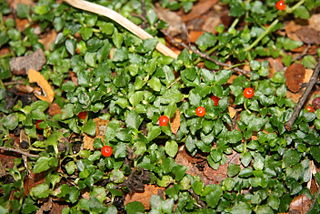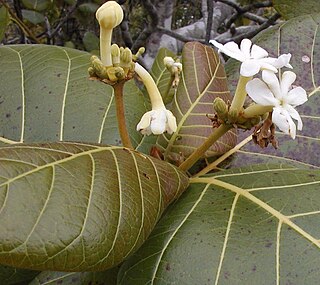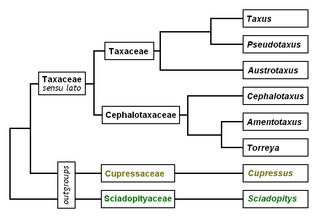Crosswort is a common name for several species of plants and may refer to:
- Crucianella stylosa (Rubiaceae)
- Cruciata laevipes (Rubiaceae)
- Lysimachia quadrifolia (Primulaceae, formerly Myrsinaceae)
Crosswort is a common name for several species of plants and may refer to:

The Rubiaceae are a family of flowering plants, commonly known as the coffee, madder, or bedstraw family. It consists of terrestrial trees, shrubs, lianas, or herbs that are recognizable by simple, opposite leaves with interpetiolar stipules and sympetalous actinomorphic flowers. The family contains about 13,500 species in about 620 genera, which makes it the fourth-largest angiosperm family. Rubiaceae has a cosmopolitan distribution; however, the largest species diversity is concentrated in the tropics and subtropics. Economically important species include Coffea, the source of coffee, Cinchona, the source of the antimalarial alkaloid quinine, some dye plants, and ornamental cultivars.

Uncaria is a genus of flowering plants in the family Rubiaceae. It has about 40 species. Their distribution is pantropical, with most species native to tropical Asia, three from Africa and the Mediterranean and two from the neotropics. They are known colloquially as gambier, cat's claw or uña de gato. The latter two names are shared with several other plants. The type species for the genus is Uncaria guianensis.
Water dropwort is a common name for several genera of plants and may refer to:

Nertera is a genus of about 15 species of flowering plants in the family Rubiaceae, native to the Southern Hemisphere, in South America and Australasia, with one species extending into the Northern Hemisphere in Central America, eastern Asia, and Hawaii. The name derives from the Greek word nerteros, meaning low down. Common names include pincushion, coral bead or bead plant. They are prostrate, creeping, mat-forming herbaceous perennial plants growing to 20–40 cm (7.9–15.7 in) across or more but no more than a few centimetres high. The leaves are usually quite small, and when crushed may in some species release a foul smell (methanethiol) like the related woody genus Coprosma. The flowers are insignificant and probably wind-pollinated. The fruit is usually a bright orange berry, but in some species may be a dry capsule.
Manono may refer to:
Kopiko may refer to:
Buttonbush is a common name for several plants and may refer to:
Randia can refer to the following creatures :

Guettarda is a plant genus in the family Rubiaceae. Most of these plants are known by the common name Velvetseed. Estimates of the number of species range from about 50 to 162. Most of the species are neotropical. Twenty are found in New Caledonia and one reaches Australia. A few others are found on islands and in coastal areas of the Indian and Pacific Oceans.

Lasianthus is a genus of flowering plants in the family Rubiaceae. They are tropical subshrubs, shrubs, or rarely, small trees. They inhabit the understory of primary forests. None of them are known to have any use.
Machaonia is a genus of flowering plants in the family Rubiaceae. It has about 32 species. All are indigenous to the neotropics. None has a unique common name. Some species have been called "alfilerillo", a Spanish name for the common and well-known genus Erodium. The type species for Machaonia is Machaonia acuminata.
Camphorweed is a common name for several plants and may refer to:
Odoratus is a Latin adjective meaning "fragrant, perfumed", and may refer to:

Sagebrush is the common name of several woody and herbaceous species of plants in the genus Artemisia. The best known sagebrush is the shrub Artemisia tridentata. Sagebrushes are native to the North American west.

Yew is a common name given to various species of trees.

Bulrushes is the vernacular name for several large wetland grass-like plants in the sedge family (Cyperaceae).
Lucidus may refer to:
Patens may also refer to:
P. montana may refer to:
Bellardia may refer to: